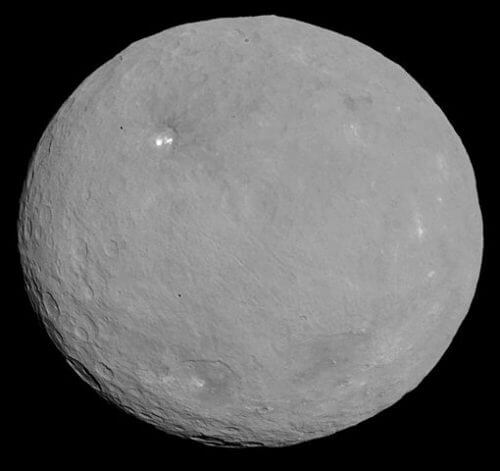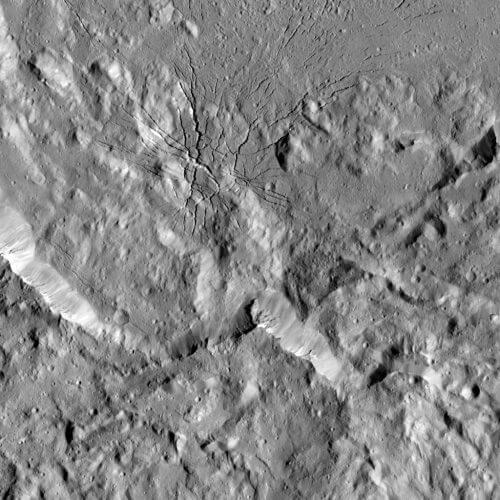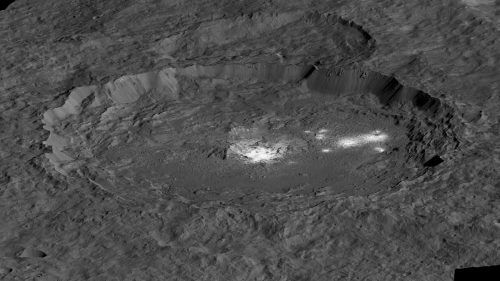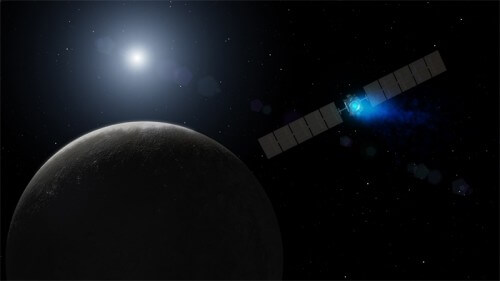The dwarf planet Keres, the largest body in the asteroid belt, has been studied by the NASA Dawn spacecraft since 2015. Below are additional findings from the study of its unique characteristics, including its bright spots.

It turns out that Keres is much more "wrinkled" than they thought. The surface is not flat and looks more wavy and is covered with many craters (1). Cracking of the surface as evidence of tectonic activity is extremely limited. One system of cracks was named Nar Sulcus, it is 50 km long and is the only one of its kind. It has several sockets parallel to each other. It is found in the Yalode crater and is related to its formation process (2).
A second cracking system looks like a spider, a series of cracks radiating from a common center, each in a different direction. It is located in the southwestern part of the Occator crater and is probably related to the material that came up from below to the surface and formed a dome formation that cracked over time. A second possibility is that it is a deformation that developed following an underground reservoir of icy magma near the surface (3).

3 types of rockslides were identified on the surface(4):
- Gliding of large, rounded lumps that have thick finger formations at their ends and resemble glaciers and ice avalanches in Earth's arctic regions. They are found mainly in high latitudes, places where most of the ice is near the ground.
- Avalanches are the most common on Keres and are similar to the deposits left by avalanches on Earth. They are thinner and longer than the first type and are found in medium latitudes.
- Formed when part of the ice melts during impact events that create craters.
To date, more than 300 bright areas have been found on a hook and 4 types (5) are distinguished: the first type includes the strongest reflective spots. They are found at the bottom of craters. The most prominent crater in this respect is the Occator crater known for its two bright spots. One spot is Cerealia Facula located in the center of the crater and is 10 km long. The second spot Vinalia Faculea is to the east of it and is less reflective. All the bright spots in this crater are made of materials rich in salts that in the distant past were probably mixed with water.
The second type is found at the summits of craters and descends along the slopes to the bottom of the craters. The meteorites that formed the craters exposed materials that were underground or were formed during other collisions. The third type, its materials were thrown during the impact of meteorites that created the craters.

The fourth type is found in the mountain Mons Ahuna which is a product of cryovolcanism. 12 places rich in sodium carbonate have been identified. In the test and in several places with an area of several square kilometers, hydrated carbonates were found for the first time on the surface of the ground and they were exposed due to the recent ice activity (6).
Water ice is found in various places on the hook and this is thanks to "ice traps". These are actually craters found at the poles that the sunlight does not reach due to the slight inclination of the axis of rotation of Keres and they are very ancient. Because of his light disposition on his axis these places are dark for his entire year.

They originated in the asteroid crust or came from space itself (7). If they originate from the crust, it is likely that Keres once had a subsurface water ocean and may still exist today. The Dawn spacecraft found carbonate materials forming in the oceans (6). If this is indeed the case, it could be that in the past there were eruptions of water to the surface, such as the geysers of Enceladus. It is possible that this phenomenon still exists today when Keres enters his perihelion (the author's hypothesis - Haim Mazar). The location of that ocean should be slightly below the surface.
A combination of the spacecraft's discoveries relating to the geological and physical findings gives an overall view that led to the conclusion that the hook has a 40-km thick crust rich in water, salts and probably also organic materials. This thickness is average and there may have been changes to the surface that exposed parts below the ground and that the cream is not homogeneous (6).
Sources
- Stephen Clark, dawn mission expected to go into overtime of Ceres, 6.4.2016
- PIA21400 : Nar Suclus
- PIA22091: Spiderweb-like fractures in Occator Crater
- Landslides on Ceres reflect hidden ice, 19.4.2017
- Bright areas on Ceres suggest geological activity, 12.12.2017
- NASA Dawn reveals recent changes in Ceres' surface, 15.3.2018
- Grossman David, Dwarf planet Ceres is covered with water-ice, 16.12.2016
